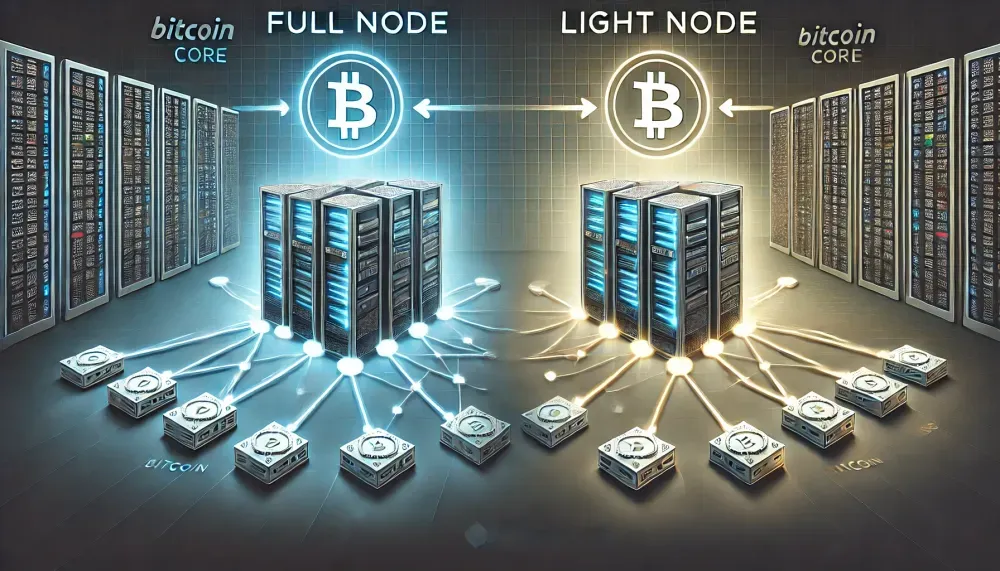Understanding the Differences Between Full Node and Light Node in Bitcoin Core

Bitcoin is a decentralized network that relies on nodes to maintain its security, transparency, and functionality. In the Bitcoin network, there are different types of nodes that play specific roles. The two main types of nodes in Bitcoin are full nodes and light nodes. While both types participate in the network and process transactions, they differ in terms of functionality, security, and resource requirements.
In this article, we’ll explore the differences between a full node and a light node in Bitcoin Core and help you understand which might be better for your needs.
What Is a Full Node in Bitcoin Core?
A full node is a node that downloads the entire Bitcoin blockchain and independently verifies all transactions and blocks according to Bitcoin’s consensus rules. It is a key component in maintaining the decentralization and security of the Bitcoin network.
Functions of a Full Node:
- Complete Blockchain Validation: A full node downloads the entire blockchain (over 500 GB as of 2024), stores it, and validates all transactions and blocks. This ensures that every rule in the Bitcoin protocol is followed.
- Network Security: Full nodes verify transactions and ensure they follow Bitcoin’s rules. They don’t rely on other nodes or third-party services, making them the most secure and reliable form of node operation.
- Propagation of Transactions and Blocks: Full nodes help maintain the network by propagating valid transactions and blocks to other nodes. This ensures the Bitcoin network remains decentralized and secure.
- Independence: Full nodes operate independently, meaning users are not required to trust any third parties for transaction validation.
What Is a Light Node in Bitcoin Core?
A light node, also known as a SPV (Simplified Payment Verification) node, does not download the full blockchain. Instead, it only downloads block headers, which are much smaller in size (80 bytes per block compared to full blocks that are over 1 MB). Light nodes verify transactions using this partial blockchain data by querying full nodes for more detailed information.
Functions of a Light Node:
- Partial Blockchain Download: Light nodes only download block headers instead of full blocks, which makes them much lighter and faster to set up.
- Transaction Verification via SPV: Light nodes use the SPV method to verify transactions by confirming that a transaction is included in a block. They do not independently validate the entire transaction history or blocks like full nodes do.
- Reliance on Full Nodes: Since light nodes do not store the full blockchain, they rely on full nodes for transaction data and verification, which means they are less independent than full nodes.
- Lightweight Setup: Light nodes are ideal for users who don’t want to or cannot run a full node, as they require significantly less storage and computing power.
Key Differences Between Full Node and Light Node
| Feature | Full Node | Light Node (SPV Node) |
|---|---|---|
| Blockchain Storage | Downloads the entire blockchain (over 500 GB) | Only downloads block headers (80 bytes/block) |
| Transaction Validation | Independently validates all transactions and blocks | Relies on full nodes for transaction verification |
| Security Level | High – provides maximum security and follows all consensus rules | Lower – trusts full nodes for transaction data and verification |
| Resource Requirements | High – needs significant storage, bandwidth, and time to sync the entire blockchain | Low – requires minimal storage and bandwidth, faster to sync |
| Network Participation | Actively helps maintain and propagate the network | Relies on full nodes to receive and propagate transactions |
| Privacy | High – does not rely on third parties for transaction validation | Lower – depends on full nodes, which may expose transaction data to third parties |
| Independence | Fully independent, no reliance on other nodes | Dependent on full nodes for blockchain data |
| Setup Time | Longer setup time due to downloading the entire blockchain | Faster setup due to smaller data downloads |
Advantages of Running a Full Node
- Maximum Security: Full nodes provide the highest level of security because they independently verify all Bitcoin transactions and blocks. This ensures users are not vulnerable to attacks or false information propagated by malicious nodes.
- Complete Control: Running a full node allows users to enforce their own rules, validating transactions without relying on any other nodes. This ensures that no false or manipulated transactions can affect their experience.
- Supports the Network: Full nodes contribute to Bitcoin’s decentralization by participating in validating and propagating transactions. They help ensure that the network remains strong and resistant to censorship.
- Better Privacy: Full nodes do not need to query other nodes for transaction data, providing better privacy compared to light nodes, which rely on external nodes for information.
Disadvantages of Running a Full Node
- Resource-Intensive: Full nodes require substantial storage space (500 GB+), bandwidth, and processing power to download and verify the entire blockchain. This can be costly for users with limited resources.
- Longer Setup Time: Syncing the full blockchain can take hours or even days, especially for new users. This can be a barrier for those who want to quickly access and use the Bitcoin network.
- Maintenance: Running a full node requires regular updates and maintenance to ensure it stays up to date with Bitcoin’s latest protocol changes.
Advantages of Using a Light Node
- Low Resource Requirements: Light nodes require minimal storage, bandwidth, and processing power, making them ideal for users with limited resources or those running Bitcoin on mobile devices.
- Faster Setup: Since light nodes only download block headers, they can sync with the Bitcoin network much faster than full nodes. This allows users to start verifying transactions and using the network quickly.
- Convenience: Light nodes are simple to set up and require less technical knowledge, making them suitable for casual users who want to send and receive Bitcoin without managing a full node.
Disadvantages of Using a Light Node
- Lower Security: Light nodes rely on full nodes for transaction data, which makes them less secure than full nodes. They are vulnerable to attacks if they connect to malicious full nodes or rely on inaccurate data.
- Less Privacy: Because light nodes need to query full nodes for transaction information, they expose some data to third parties, potentially compromising user privacy.
- Reliance on Full Nodes: Light nodes are dependent on full nodes for blockchain data, which means they lose some level of independence and control.
Which Should You Use: Full Node or Light Node?
- Full Node: If you want maximum security, control, and privacy, and are willing to dedicate resources (storage, bandwidth, and time) to maintaining a full node, then running a full node is the best option. Full nodes are ideal for those who want to contribute to Bitcoin’s decentralization and take full responsibility for validating transactions.
- Light Node: If you’re a casual user who wants to quickly interact with the Bitcoin network without downloading the full blockchain, or if you’re using a mobile device with limited storage and processing power, a light node is the more practical choice. Light nodes are easier to set up and require fewer resources, but they come with trade-offs in terms of security and privacy.
Conclusion
In the Bitcoin network, full nodes and light nodes serve different roles, each with its own advantages and disadvantages. Full nodes offer maximum security, independence, and privacy but require significant resources. Light nodes are easier to use and set up, making them ideal for casual users or those with limited resources, though they come with reduced security and reliance on full nodes.
Ultimately, the choice between a full node and a light node depends on your needs, technical expertise, and available resources.
This article presented by Loka Mining.
Loka is revolutionizing the Bitcoin mining ecosystem by directly connecting investors with Bitcoin miners through a decentralized mining pool and an upcoming permissionless forward hashrate marketplace protocol.
Loka enables investors to get Bitcoin at lower than market price without centralized & counter-party risks, and Bitcoin miners to access capital efficient financing and hedge their risk exposure by selling their future mining rewards.
Find out more about loka in https://lokamining.com — or access our mining pool aggregator on https://pool.lokamining.com





